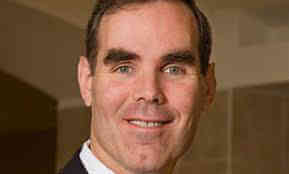US District Judge Reed O'Connor. | US DISTRICT COURT FOR THE NORTHERN DISTRICT OF TEXAS
In an 11th-hour action, US District Judge Reed O’Connor issued a December 31 nationwide preliminary injunction barring the federal government from enforcing part of a new regulation scheduled to go into effect on New Year’s Day that would have interpreted the prohibition on discrimination because of sex under the Affordable Care Act (ACA) to extend to discrimination because of “gender identity” and “termination of pregnancy.”
The unlikelihood that the incoming Trump administration would defend the regulation in any appeal of the preliminary injunction means that O’Connor has probably gutted those nondiscrimination protections for good, even if Obamacare itself survives in some form going forward.
O’Connor, who sits on the Northern District of Texas bench in Wichita Falls, had issued a similar nationwide preliminary injunction regarding the federal government’s enforcement of Title IX of the 1972 federal education statute to protect transgender schoolchildren from discrimination.
O’Connor’s newest ruling came in Franciscan Alliance v. Burwell.
Federal judge halts pending regulation barring gender identity discrimination under Obamacare
In both opinions, O’Connor rejected the Obama administration’s position that discrimination because of gender identity or expression is a form of “sex discrimination” that is illegal under federal law. The US Supreme Court may address that question in G.G. v. Gloucester County School Board, a case before it involving the efforts of a teenage transgender boy, Gavin Grimm, to use the bathroom corresponding to his gender identity at his Virginia high school.
Since the ACA’s nondiscrimination provision incorporates by reference the sex discrimination ban in Title IX that O’Connor earlier ruled on, his analysis followed closely on his August injunction.
The ACA provides that health programs or activities receiving federal funding not discriminate on grounds prohibited by four federal statutes and authorizes the Department of Health and Human Services (HHS) to adopt regulations in line with those requirements. Title IX, which bans sex discrimination in federally-funded educational programs, was one of those four statutes.
When Title IX regulations were adopted by the Education Department in the 1970s, they included an express religious exemption provision for cases where compliance would violate the tenets of a religiously-controlled educational institution.
In the years that HHS worked on developing the regulations due to take effect this week, the views of several federal agencies responsible for enforcing sex discrimination bans were evolving regarding gender identity.
The Equal Employment Opportunity Commission was the first government agency to issue a ruling, in the context of a federal job applicant’s complaint, that gender identity discrimination was barred by the sex discrimination provisions of Title VII of the 1964 Civil Rights Act. The EEOC’s analysis followed a ruling from the Sixth Circuit Court of Appeals, which arrived at the same conclusion by applying a US Supreme Court precedent dating to 1989, in Price Waterhouse v. Hopkins, which found that the sex stereotyping that firm used in denying partnership to a woman deemed insufficiently feminine was a violation of Title VII.
The HHS regulation drafters adopted similar reasoning to the EEOC and the Sixth Circuit in including “gender identity” in their proposed regulation, published in final form this past May.
By that time, the Education Department had taken the position that Title IX bans gender identity discrimination, in the context of Gavin Grimm’s restroom access dispute with the Gloucester County School District. The DOE posted its position on its website and sent a “Dear Colleague” letter to school districts nationwide.
HHS, however, did not include in its final rule the religious exemption language from Title IX.
Several states and some religious health care providers joined together to challenge the new HHS rule, not in its entirety but in a focused attack on the inclusion of “gender identity” and “termination of pregnancy” in the non-discrimination provisions.
In a blatant example of venue shopping, they filed their suit in the Wichita Falls federal court, where O’Connor, appointed to the bench by President George W. Bush, is the only judge. O’Connor’s action in the Title IX case in August was not the first of its kind; he has demonstrated a propensity to issue nationwide injunctions against Obama administration regulatory actions on grounds that they exceed executive branch authority.
In the ACA case, the plaintiffs were able to justify their choice of venue by pointing to local members of the co-plaintiff Christian Medical & Dental Association (CMDA), a national organization, who reside within the geographical confines of the Wichita Falls court as well as to local Texas state agencies whose operation in that area would be affected. Other private plaintiffs are Franciscan Alliance, Inc. and its wholly owned entity Specialty Physicians of Illinois LLC.
Texas Republican Attorney General Ken Paxton. | TEXAS ATTORNEY GENERAL'S OFFICE
The public plaintiffs are the states of Texas, Wisconsin, Nebraska, Kansas, Louisiana, Arizona, Kentucky, and Mississippi. The heavy hand of Texas Attorney General Ken Paxton looms over the litigation, since Paxton has said, in effect, that his job is to sue the federal government every day on behalf of the right of Texas to operate free of federal regulatory constraints.
The parties in this case have a basic argument over the requirements imposed by the HHS rule. The plaintiffs argue they would be required to provide gender transition surgery and abortions or suffer liability to patients as well as potential loss of federal funding. They claim this would violate their rights under the federal Religious Freedom Restoration Act, and that the government’s interpretation of the ban on sex discrimination to cover “gender identity” and “termination of pregnancy” went beyond its regulatory authority.
HHS argues that the rule does not compel either procedure in every case, merely banning discrimination based on gender identity or a patient having terminated a pregnancy. A health care provider that performs mastectomies, then, could not take the position that it will not perform a mastectomy for a transgender man as part of his transition process since this would be sex discrimination. Likewise, a cisgender woman suffering an estrogen deficiency can receive hormone therapy, and so can a transgender woman.
The religious institution plaintiffs, in effect, argue that the non-discrimination requirement would inevitably require them to perform procedures that violate their religious views. The state plaintiffs, meanwhile, argue the rule would require them to violate their own laws and regulations, such as banning abortions in state facilities or the use of state Medicaid funds for gender transition or abortions.
O’Connor agreed with the religious institution plaintiffs that however the dispute over interpretation is resolved, there is a likelihood that their exercise of religion would be substantially burdened.
In issuing a preliminary junction, O’Connor first considered the plaintiffs’ likelihood of success on the merits, and he found that Title IX does not on its face ban discrimination because of “gender identity” or “termination of pregnancy.”
Much of his discussion involves the gender identity issue, and there he channels his analysis from the August Title IX injunction. His discussion of the abortion issue focuses on the failure of HHS to incorporate in its new regulation the religious and abortion exemptions in existing Title IX regulations.
On gender identity, O’Connor’s bottom line is that “the meaning of sex in Title IX unambiguously refers to ‘the biological and anatomical differences between male and female students as determined at their birth.’” Because there is no ambiguity, the judge was unwilling to accord HHS the deference typically due an agency in adopting regulations to carry out its statutory responsibilities.
Relying, as well, on what he termed the “ordinary meaning” of sex discrimination, O’Connor also noted that as of the time Congress enacted the ACA in 2010, federal agencies had not yet begun to treat “gender identity” discrimination as covered by sex discrimination statutes.
In a footnote, he rejected the government’s attempt to bolster its case by reference to the Price Waterhouse sex stereotyping precedent, pointing out that the ACA incorporated federal education law’s Title IX, not the Title VII employment nondiscrimination provisions.
O’Connor also found that Congress, in incorporating Title IX’s nondiscrimination provisions, intended to include its religious exemption language.
“Title IX prohibits discrimination on the basis of sex, but exempts from this prohibition entities controlled by religious organizations when the proscription would be inconsistent with religious tenets,” O’Connor wrote. “Title IX also categorically exempts any application that would require a covered entity to provide abortion or abortion-related services… Therefore, a religious organization refusing to act inconsistent with its religious tenets on the basis of sex does not discriminate on the ground prohibited by Title IX.”
O’Connor bolstered this point by invoking the Supreme Court’s 2014 ruling that gave the Hobby Lobby corporation the right to claim a religious exemption from the ACA’s requirement to provide employee health coverage for contraceptive and abortion services. Taking his cue from Justice Samuel Alito’s opinion in that case, O’Connor pointed out that the government could offer to pay for transition and abortion services to be provided by those who did not have religious objections to them in order to avoid burdening a plaintiff’s religious rights.
O’Connor also cited an HHS study showing that the medical community is not unanimous on the value and necessity of performing transition procedures, particularly on minors. That study, he found, undermined any argument that the government has a “compelling interest” that properly overrides the rights of health care providers with sincere religious objections to performing such procedures.
Given his conclusion that the plaintiffs were likely to succeed on the merits, O’Connor found that they easily satisfied the other requirements for preliminary injunctive relief, noting in particular the risk that religious institution plaintiffs could suffer the loss of federal funding if the rule went into effect.
Given the reach of the rule and the fact that some of the plaintiffs operate across the country, O’Connor concluded that a nationwide injunction “is appropriate.”
A preliminary injunction stays in effect until the court issues a ruling on the merits, unless it is reversed on appeal. As of December 31, the Obama administration had barely three weeks left in office, to be succeeded by an administration much less likely to defend the HHS regulation. As a result, O’Connor’s ruling signals a major and probably long-term setback to efforts by transgender people to obtain non-discriminatory health care, including coverage for medically-necessary transition procedures.




































